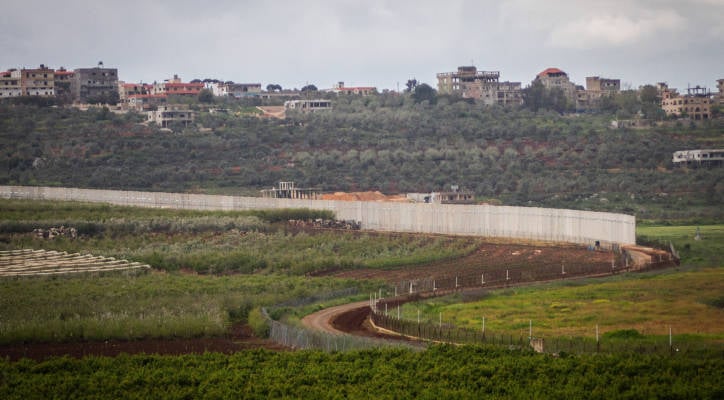‘Everyone from Yiftah has accepted that we’re not going home anytime soon.’
By Judy Lash Balint, JNS
Ten years before the founding of the state, during the Arab revolt of 1936-1939 in Mandatory Palestine, Zionist pioneers built more than 55 settlements in hostile areas. The “Tower and Stockade” program was the fulfilment of David Ben-Gurion’s vision to put facts on the ground to stake out the borders of the future State of Israel.
In the nine decades since, hundreds of thousands of Israelis have made their homes close to the country’s borders in dozens of communities and towns. Since Oct. 7, almost all those living next to the northern and southern borders have been displaced and are living in limbo, waiting for a sign that it might be safe to go home.
Liz Dovrat, 42, her husband and three young children were instructed by the Israel Defense Forces to leave their house in Kibbutz Yiftah near the Lebanese border on the morning of Oct. 8, along with all 600 other kibbutz residents. “We packed for six days, and left within two hours,” she told JNS. “I’ve not been back.”
Dovrat, who made aliyah from Virginia Beach, Va. in 2007, says the horror of what occurred in many kibbutzim on the southern border left her thinking “that could have been me. I’m on a kibbutz, I’m a mom of young kids.”
Despite the proximity to the border with Lebanon, Dovrat says that in the 10 years her family has lived in Yiftah she could only recall a few instances when they had to enter a shelter. “We heard about the Hezbollah tunnels, but it never felt real. Even now it’s hard to digest that the threat is real,” she admitted.
Over the past few months since they left, the now deserted Yiftah and nearby Kibbutz Manara have been heavily shelled from Lebanon by Hezbollah.
Dovrat describes how she and her husband fell in love with the north— the natural beauty, the rural lifestyle and the sense of community. “It’s a peaceful life. I always loved the idea of knowing that my kids would grow up with the same group of kids and be part of a community where everyone knows your name,” she said.
According to Dovrat, her 8-year-old twin girls and 4-year-old son are adjusting well to their temporary home in Hod Hasharon in central Israel, which is close to their grandparents, and understand why they had to desert their kibbutz.
“It was heartbreaking,” Dovrat admitted. “I don’t overshare, but I believe in telling my kids the truth. My 4-year-old knew we were leaving because of Hamas, and that we were worried that Hezbollah was going to do the same.”
Even before the war, Dovrat said she told her kids, “That’s Lebanon—even though it’s so close, we can’t go there. Unfortunately, there are people who don’t like us and that’s why we can’t go there.” Her 4-year-old told her recently, “I hope Hamas stops the war, I want to go back to my preschool.”
Dovrat is the head of the English unit at Tel Hai Academic College, which has been designated as a closed military area. Online classes are set to start this week and she expressed concern over possible friction as Arab and Jewish students interact for the first time since the start of the war.
As for going home—Dovrat told JNS that “everyone from Yiftah has accepted that we’re not going home anytime soon.”
Dovrat shares her experiences in the “Life on the Border with Gaza” Facebook group, that now includes evacuees from northern Israel as well as those who survived Hamas’s Oct. 7 onslaught on southwestern Israel.
Survivor from Kibbutz Be’eri
Haim Yellin, 65, is a survivor from Kibbutz Be’eri, where 95 people were killed and 30 abducted by Hamas. He served as head of the Eshkol Regional Council between 2007-2015 and as Knesset member for Yesh Atid between 2015-2019.
Yellin makes regular trips to his devastated kibbutz from his temporary home at a Dead Sea hotel. “I miss my house; I miss walking the pathways; I miss my friends; I miss simply being able to make an omelet and a salad in my own space,” he said.
But Yellin’s main purpose at the kibbutz is to lead groups of soldiers to see the burned-out homes “so they understand what they’re fighting for.”
“There’s no cause more just than having the ability to raise our kids in peace,” said Yellin. “That’s only possible because of the IDF. These guys are giving up their lives so that we can live in this place.”
Yellin emphasizes to visitors that the situation of Israeli soldiers fighting in Gaza to protect the lives of fellow citizens just across the border is unique in the world. “They’re not fighting a war thousands of miles away. They’re fighting so we can all have a better, safer life,” he said.
Yellin is full of praise for the dozens of young Israeli volunteers who have descended on the kibbutz to help with the “renewal.” The communal dining room and the print shop at Be’eri were not damaged on Oct. 7 and both quickly reopened. Today hundreds of workers and volunteers eat lunch in the kibbutz dining room every day.
“We have to overcome the sorrow and invest our energy in looking forward, into rebuilding,” Yellin stated emphatically. “I’m not dealing with the anger, with trying to understand how this could happen in 2023, when we have the best army in the world. That’s a pointless waste of energy.”
While no one can tell Haim Yellin or Liz Dovrat when they’ll be going home to resume normal life, Yellin believes that the pubs in Tel Aviv should be open and filled with people. “We‘ll do everything to show our enemies that we’ll be as it says in ‘Hatikvah,’ our anthem: “A free people in our own country.”
